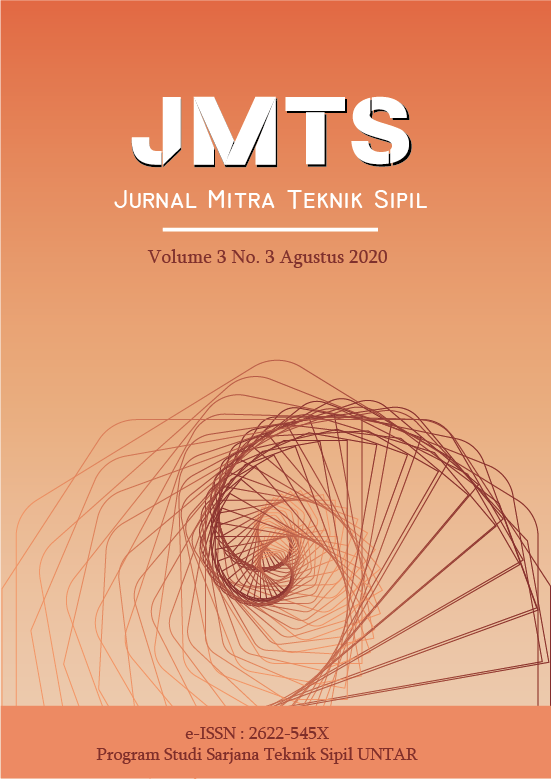KARAKTERISTIK MEKANIS CAMPURAN LASTON ATAS DENGAN BUBUK GRAFIT SEBAGAI BAHAN PENGGANTI FILLER
Main Article Content
Abstract
In road pavement modifications, many use materials that have good conductivity to be added to the mixture. One of the conductive materials that can be used for pavement is graphite powder. Graphite is usually found in pencils, raw materials for batteries, etc. The use of graphite powder in the pavement mixture has many benefits such as self-healing, self-monitoring, etc. This research uses graphite powder as filler replacement material. Tests conducted in this study is testing the characteristics of the mixture in accordance with the provisions in force in Indonesia. This study uses graphite powder with variations of 5%, 10%, 15%, and 20% with asphalt content of 5.7%. From the results of testing the characteristics of the mixture continued with the determination of optimum graphite powder content using the narrow range method. Then proceed with the mechanistic response analysis using the KENPAVE program. The results of this study largely meet the requirements of the General Specifications of the Directorate General of Highways 2018 Edition Division 6 and the 2017 Pavement Road Design Manual. The results of this study indicate that the use of graphite powder as a filler substitute can be used in Indonesia.
ABSTRAK
Pada perkerasan jalan modifikasi, banyak menggunakan bahan yang mempunyai konduktivitas yang baik untuk ditambahkan dalam campuran. Salah satu bahan konduktif yang dapat digunakan untuk campuran perkerasan adalah bubuk grafit. Grafit biasanya terdapat pada pensil, bahan baku baterai kering, dll. Penggunaan bubuk grafit dalam perkerasan memiliki banyak manfaat seperti self-healing, self- monitoring, dll. Penelitian ini menggunakan bubuk grafit sebagai bahan pengganti filler. Pengujian yang dilakukan pada penelitian ini adalah pengujian karakteristik campuran yang sesuai dengan ketentuan yang berlaku di Indonesia. Penelitian ini menggunakan bubuk grafit dengan variasi 5%, 10%, 15%, dan 20% dengan kadar aspal 5,7%. Dari hasil pengujian karakteristik campuran dilanjutkan dengan penentuan kadar bubuk grafit optimum dengan metode narrow range. Kemudian dilanjutkan dengan analisis respons mekanistik dengan menggunakan program KENPAVE. Hasil penelitian ini sebagian besar memenuhi persyaratan Spesifikasi Umum Direktorat Jendral Bina Marga Edisi 2018 Divisi 6 dan Manual Desain Perkerasan Jalan 2017. Hasil penelitian ini menunjukkan bahwa penggunaan bubuk grafit sebagai bahan pengganti filler dapat digunakan di Indonesia.
Article Details
References
Hardiyatmo, Hary Christady. "Pemeliharaan Jalan Raya". Yogyakarta: Gadjah Mada University Press, 2015. 119-122. Cetak.
Heliyati, Carolina Aprilia and Berlian Kushari. "Perbandingan Perencanaan Tebal Perkerasan Lentur Jalan dengan Metode Empirik dan Mekanistik-Empirik Pada Ruas Jalan Mlati-Cebongan-Seyegan". The 19th International Symposium of FSTPT, Islamic University of Indonesia. (2016): 981-991. Prosiding Forum Studi Transportasi antar Perguruan Tinggi. Web. 13 Juni. 2020.
Indonesia. Surat Edaran Direktorat Jendral Bina Marga Nomor: 04/SE/Db/2017: Manual Desain Perkerasan Jalan 2017. Jakarta: Direktorat Jendral Bina Marga, 2017.
Indonesia. Surat Edaran Direktorat Jendral Bina Marga Nomor: 02/SE/Db/2018: Spesifikasi Umum 2018 Untuk Pekerjaan Konstruksi Jalan dan Jembatan. Jakarta: Direktorat Jendral Bina Marga, 2018.
Kok, Baha Vural, Mehmet Yilmaz and Yunus Erkus. "Effect of Graphite on Mechanical Properties of Stone Mastic Asphalt Pavement". Journal Of Civil Engineering and Management. (2017): 1013-1020. ResearchGate. Web. 5 Februari. 2020.
Liu, Xiaoming and Shaopeng Wu. "Study On The Graphite and Carbon Fiber Modified Asphalt Concrete". Construction and Building Materials. (2010): 1807-1811. ScienceDirect. Web. 5 Februari. 2020.
Liu, Xiaoming, et al. "Properties Evaluation of Asphalt- Based Composites with Graphite and Mine Powder". Construction and Building Materials. (2007): 121-126. ScienceDirect. Web. 5 Februari. 2020.
Wu, Shaopeng, et al. "Self-Monitoring Electrically Conductive Asphalt-Based Composite Containing Carbon Fillers". Transactions of Nonferrous Metals Society of China. (2006): 512-516. ScienceDirect. Web. 5 Februari. 2020.



